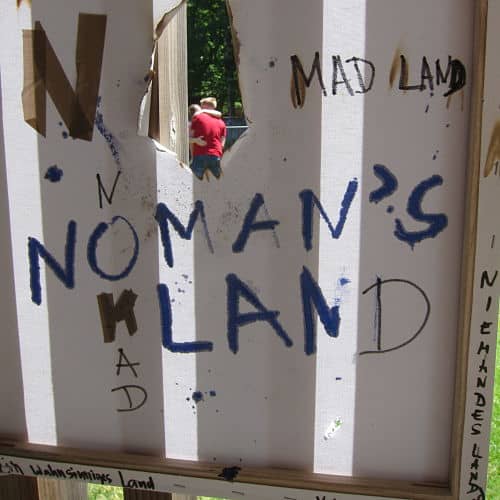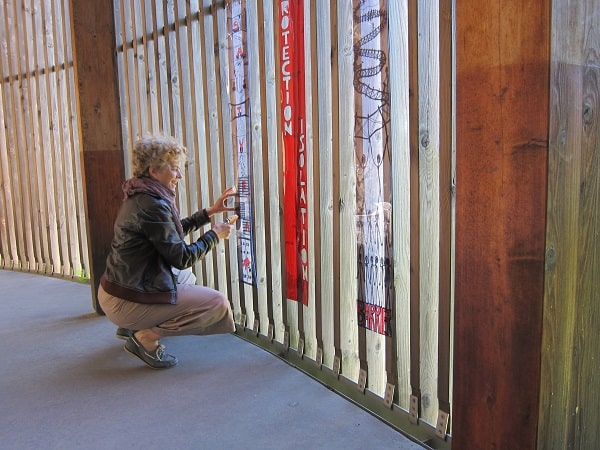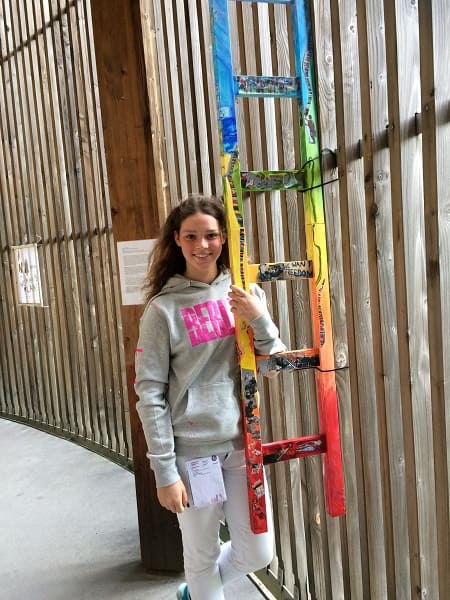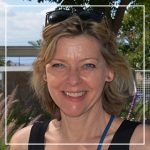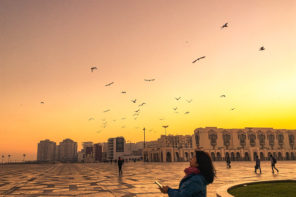The Moving Matters Traveling Workshop (MMTW) evolves by “settling” into one site after another. In each location, the workshop works with a local institution. For this month’s exhibition and performances in Berlin, MMTW has partnered with the parishes of the Chapel of Reconciliation and St. Stephen’s Church and the Refugee Office of Protestant Dinary, Berlin North East, where Lisa Strehmann is a coordinator. Lisa talks with Susan Ossman – the MMTW creative director and producer and professor of anthropology at UC Riverside – about the project and its link with her work with refugees.
“Walls” by the MMTW is on view through July. Performances are on Friday, 30 June at 19h and Saturday, 1 July at 17h.
Susan: You work as a coordinator at the Refugee Office of the Protestant Dinary of Berlin North-East. Can you say a word about your work and how it relates to the MMTW project in Berlin?
Lisa: My colleague and I counsel and support the parishes’ employees and volunteers who deal with refugees and also refugees themselves. We cooperate with public administrations, lawyers and community associations to counsel people about administrative, legal, political, social and cultural questions. Since the end of 2016 the mediation and support of Church Asylums has taken more of our energy. Church asylum is a form of temporary protection for refugees without the status of legal residence who would face unacceptable social hardship, torture or even death if forced to return to their country of origin. During the church asylum, all relevant legal, social and humanitarian aspects of the cases are examined. Many times, it turns out that the state authorities’ decision needs to be revised, which means that a new asylum procedure has a chance of success. There is no legal right of Church Asylum but it is like an agreement between the German State and the Church because of a long tradition.
When we meet people in need, we don’t see them as cases or numbers. We pay attention to all of their background and competencies. We believe that personal encounters are the first step to social participation, and that they also help for finding work, not to mention learning German. Personal encounters enrich the lives of all participants and reinforce mutual understanding. We set up opportunities for encounters in our get-together cafés which are organized by volunteers from our Church in parish rooms or in cooperation with local associations. Concerts, cultural or informational activities can take place during these cafés, which bring together refugees with Christian or Muslim background and locals with or without any religious background.
To reach our goals we have had to develop new ways of thinking about complicity and new ways of working to build up new synergies among public institutions, associations, parishes and initiatives from communities. Bringing all of these institutions and groups together is a kind of border- crossing.
For me “integration” is a mutual process of questioning our identity and values in order to find a common narrative of a peaceful and respectful living together.
By bringing people from different countries, origins, professions together with the common goal to create something collectively and also individually, the MMTW naturally shares our objectives.
How did you become acquainted with the MMTW and what made you want to work with us?
I used to work on the Greater Paris Reform Process, for the Parisian suburb of Clichy. In Clichy I met Guillaume Lasserre, who was the founding director of Clichy’s Pavillon Vendome contemporary Arts Center, the place where the MMTW presented a performance in 2013. I saw the MMTW performance in Clichy in 2013 and I was very moved by your work. So I was excited when I heard you would be in Berlin in 2016-17. Guillaume introduced us online and we met at Nola’s in the Weinbergspark on a lovely Fall afternoon. We both quickly realized that we have a lot of common interests; art, migration, collaboration. And of course, we had both spent many years in France and had our children there. So it felt natural that we should work together on a Berlin edition of MMTW for 2017.
Do you think the refugees you work with can relate to the perspectives of the MMTW and the idea of the “serial migrant”? What about yourself?
Some of them can totally relate to this perspective. Especially those who worked and studied already abroad and for whom it is not just one country they left behind. Like the artists of the MMTW they are extremely conscious that they are made up of the sum of all their destinations and experiences. They are not “shocked” by coming to Berlin. Berlin as a big metropolis is becoming not only a place of shelter but also the place where psychological, social and cultural as well as political walls can finally be pulled down for some people. Some of these “refugees” say that they can become “what they always wanted to be”. Of course this is often a kind of projection – more than reality. It’s a device many people use to confront the future. Still, I think Berlin does offer some advantages for self-realization, maybe more than other big cities.
The “serial migrant” can be seen in a very intellectual and abstract way and in that case, it is important for research but might be difficult for some people to understand. But the concept comes out of a very open minded approach to reconsidering identity as a collective, ongoing and very enriching process which is not carved into stone.
Anyone can understand questions like “How is my identity, my cultural background challenged when I arrive in a new country”? Or how can it be enriched or questioned? These are universal questions everybody should reflect upon regardless of one’s “migration path.” But for migrants, immigrants, serial migrants, like myself, they have a special importance. I am myself quite a wanderer. I think it comes from my curiosity and willingness to learn by engaging new places and people. This is not just “cultural tourism” or “cosmopolitanism.” For me, it has been a complex, sometimes difficult, even heart-wrenching process of living across several countries. The idea of the serial migrant is at the very core of my life and work.
Do you think bringing the perspective of “serial migrants” to the forefront can have a positive influence on how we think about migration more generally?
The perspective of the serial migrant opens up the discussion on public discourses about migration and integration. This discourse is generally quite negative, the media associating migration with terrorism, war, confrontation, desperation, economic and social precarity. The collective process of coming together, of creation or peacefulness is very rarely put into the focus in the general debate.
I don’t like to be qualified, categorized in general, and I don’t want to be that different from others. But of course migration changes your way of life and how you consider the world, it opens up your perspectives. One simple example; the idea of living my whole life in the same place seems not possible for me. The wanderlust always comes back. That doesn’t mean that I cannot settle somewhere for a couple of years, on the contrary Berlin is a great place to get settled for a while.
Is educating the people and institutions who work with refugees and migrants part of the goal in developing the MMTW project with the Refugee office?
I think that there has been a general change in the perception of migration in the institutions and associations which work with refugees. We can say that the volunteers and people who are working with refugees consider migration as a positive process. Our cooperation is useful to reinforce this point of view and to show how creative work can help express complex questions which are politically and culturally inexpressible by words.
And what about the theme of Walls? Berlin has a special place in the history of border walls.
As a Berliner, does the theme have a special significance for you?
It is a generational thing. I was wondering the other day how the teachers and tourist guides can make the Berlin wall understandable for teenagers or people who were born after 1990. Even for me, I was born in 1985 in the former GDR, it is quite difficult to apprehend and understand even though my family talks about it quite often. I only have a passive memory of the fall of the wall but the stories about the wall and of its coming down really touch me still. Maybe they have contributed to the joy I feel crossing borders.
You were the one who approached Pastor Thomas Jeutner about holding the MMTW events at the Kapelle der Versöhnung. What made you think of that site?
Despite the heaviness of the past-destruction of the old Church, situated on the ex-death zone, the lightness and grace of the chapel is inspiring and amazing. It literally incorporates the old but in a very contemporary way. It is turned towards the future. It is a truly inspiring place. What we really have to emphasize is how Pastor Thomas Jeutner and his team have been so incredibly welcoming to the project. They are so open minded and welcoming to art projects.
The exhibition is now up. Your thoughts and feelings about it?
When we are talking about walls in general we expect quite dark pieces. Or in my imagination about walls there is a lot of grey. In this exhibition pieces are almost all very colorful and full of life. Light and seeing through is like a red line of Walls-Mauern-Grenzen. Valentina Sartoris collective work shows portraits on pendants; she drafted the outlines of thee faces and the children from the “Pinocchio” Kindergarten and a refugee shelter in the same neighborhood filled them in with their own ideas. The portraits recall the children’s meetings, passages and exchanges over a period of a year.
Barbara Bernardi’s bright, sometimes contradictory words about walls are written on plastic to reflect the sun like stained glass on the floor and wall.
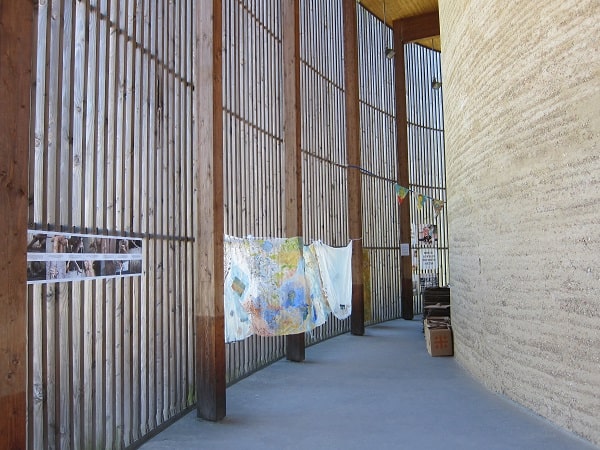
Left to right: work by Petra Fantozzi, Susan Ossman, Claudia Egholm-Castrone, and Valentia Sartori (strung above)
Your works of art blow in the wind: they invite us to travel, to move on, to take what made us (memories, people, experiences, places) with us and to stay in movement. Beatriz Mejia-Krumbein’s richly colored paintings of eyes follow us as we move: in fact, they seem to wander about.
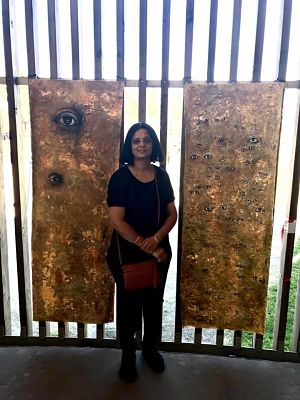
Uthra Vijay next to Beatriz Mejia-Krumbein’s “Dwelling with Walls”
And the viewers?
The Chapel of Reconciliation is definitively a great place to have set up the exhibition. In June about 1500 people visit the site each day – where else could one have such a large and varied audience? No art gallery could attract the variety and numbers the Wall Monument site does. I am curious to see how the public will interact with the exhibition and the performances. We provide an explanation for each piece and a short artist bio in German and English. Some visitors read each label carefully and move from piece to piece as though they were in a museum. Others walk around quickly and focus on one piece: the leaders of the groups of boy and girl scouts and students and senior citizens who come here develop a story about the work.
It is going to be really interesting to see the way the MMTW performances bring together the tourists, recent migrants to Berlin, artists and academics and the people from the parishes involved in the project.
You dared to make a piece – although you are not an artist – explain?
Oh well… When you and I walked around the chapel I saw this Niemandsland sign (Nomansland) and I had to do something with it. And you also motivated me to do something. Although it was funny to be in a little creative process with ink, fire etc. My thoughts were full of anger about those who declare that some people are stateless and therefore without a legal or public recognition of their person. It is very complex for those people because they are not enjoying the same level of rights as “normal” citizens, they are made “second class” citizens. It is the case for some Palestinians for example who don’t have the same asylum procedures as Syrians although they lived already as the second or third generation in Syria.
And then there were also positive thoughts about the indefinite possibilities of such a Niemandsland. A no-man’s-land is an area of unknown, unclaimed or uninhabited land. In this ambiguous, indefinite and undefined space creativity becomes possible again.

